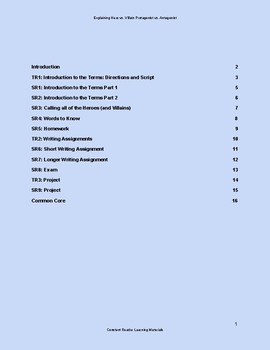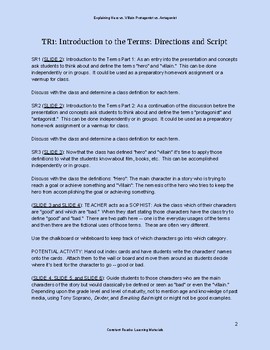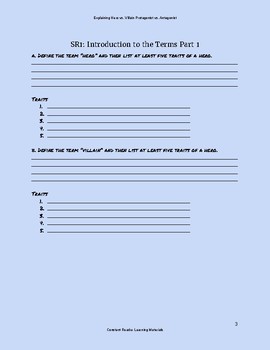Lesson Plan & PPT Package Explaining Hero vs Villain Protagonist vs Antagonist
Constant Reader Learning Materials
39 Followers
Grade Levels
6th - 12th, Higher Education, Adult Education, Homeschool
Subjects
Resource Type
Standards
CCSSW.6.2
CCSSW.6.2a
CCSSW.6.2b
CCSSW.6.2c
CCSSW.6.2d
Formats Included
- Zip
Pages
38 pages
Constant Reader Learning Materials
39 Followers
What educators are saying
I used this to plan an extensive lesson plan for a unit. This product gave me so many great ideas and was very thorough. If you are doing a unit or heroes and villains and are feeling stuck, this was a great resource and gave me a lot of inspiration.
Description
This is a two-part package -- a Power Point presentation and a lesson plan. The PPT is available separately by the same name.
This 14-slide Power Point presentation presents hero, villain, protagonist, and antagonist. It explains the shift from using the terms "hero" and "villain" to the more contemporary "protagonist" and "antagonist." The presentation also uses Greek and early English root words to explain how the terms "protagonist" and "antagonist" evolved.
The fourteen slides include 15 images, dynamic and active presentation methods, and colorful representations.
The 24-page lesson plan (15 pages of lesson and 9 pages of Common Core Standards) goes hand-in-hand with the Power Point presentation of the same name.
Material included:
9 Student Resources
3 Teacher Resources
Words to Know
Classroom Activities
Homework
Exam
Project Prompt
Essay Prompts (one long and one short)
Common Core Standards
This 14-slide Power Point presentation presents hero, villain, protagonist, and antagonist. It explains the shift from using the terms "hero" and "villain" to the more contemporary "protagonist" and "antagonist." The presentation also uses Greek and early English root words to explain how the terms "protagonist" and "antagonist" evolved.
The fourteen slides include 15 images, dynamic and active presentation methods, and colorful representations.
The 24-page lesson plan (15 pages of lesson and 9 pages of Common Core Standards) goes hand-in-hand with the Power Point presentation of the same name.
Material included:
9 Student Resources
3 Teacher Resources
Words to Know
Classroom Activities
Homework
Exam
Project Prompt
Essay Prompts (one long and one short)
Common Core Standards
Total Pages
38 pages
Answer Key
N/A
Teaching Duration
1 hour
Report this resource to TPT
Reported resources will be reviewed by our team. Report this resource to let us know if this resource violates TPT’s content guidelines.
Standards
to see state-specific standards (only available in the US).
CCSSW.6.2
Write informative/explanatory texts to examine a topic and convey ideas, concepts, and information through the selection, organization, and analysis of relevant content.
CCSSW.6.2a
Introduce a topic; organize ideas, concepts, and information, using strategies such as definition, classification, comparison/contrast, and cause/effect; include formatting (e.g., headings), graphics (e.g., charts, tables), and multimedia when useful to aiding comprehension.
CCSSW.6.2b
Develop the topic with relevant facts, definitions, concrete details, quotations, or other information and examples.
CCSSW.6.2c
Use appropriate transitions to clarify the relationships among ideas and concepts.
CCSSW.6.2d
Use precise language and domain-specific vocabulary to inform about or explain the topic.





